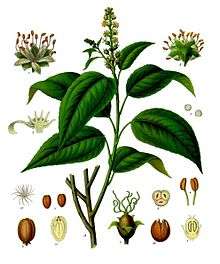Croton tiglium
| Purging Croton | |
|---|---|
 | |
| Croton tiglium | |
| Scientific classification | |
| Kingdom: | Plantae |
| (unranked): | Angiosperms |
| (unranked): | Eudicots |
| (unranked): | Rosids |
| Order: | Malpighiales |
| Family: | Euphorbiaceae |
| Subfamily: | Crotonoideae |
| Tribe: | Crotoneae |
| Genus: | Croton |
| Species: | C. tiglium |
| Binomial name | |
| Croton tiglium L.[1] (1753) | |
| Synonyms | |
| |
Croton tiglium, known as Purging Croton, is a plant species in the Euphorbiaceae family. C. tiglium is also called Jamaal Gota in Hindi and Urdu.
Traditional uses
C. tiglium is one of the 50 fundamental herbs used in traditional Chinese medicine, where it has the name bā dòu (Chinese: 巴豆). C. tiglium is known as Japaala/ජාපාල or "Jayapala" in Sinhala and used in Sinhala traditional medical system of Sri Lanka.and in sanskrit also . Seeds have a purgative effect.[3] The plant is poisonous with the bark used as an arrow poison and the seeds used to poison fish.[4]
Chemical constituents
Major known chemical constituents are crotonoleic acid,[3] glyceryl crotonate, crotonic acid , crotonic resin, and various carcinogenic phorbol derivatives.
References
- ↑ "Croton tiglium information from NPGS/GRIN". Retrieved 2008-02-19.
- ↑ Croton tiglium, theplantlist.org
- 1 2 N. R. Pillai (1999). "Gastro-intestinal effects of Croton tiglium in Experimental Animals". Ancient Science of Life. 18 (3&4): 205–209. PMC 3336487
 . PMID 22556892.
. PMID 22556892. - ↑ Croton tiglium Purdue University
External links
This article is issued from Wikipedia - version of the 3/22/2016. The text is available under the Creative Commons Attribution/Share Alike but additional terms may apply for the media files.